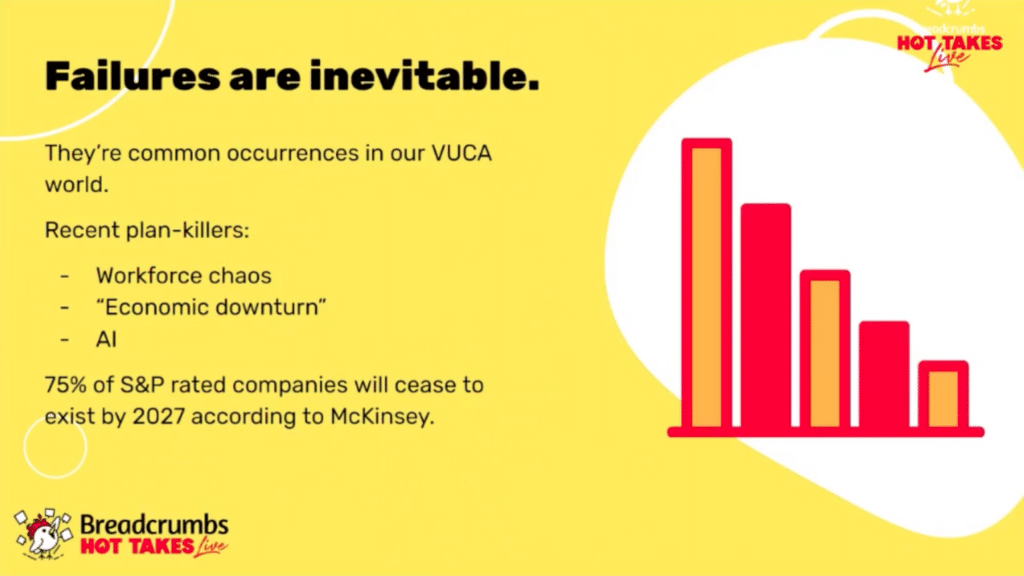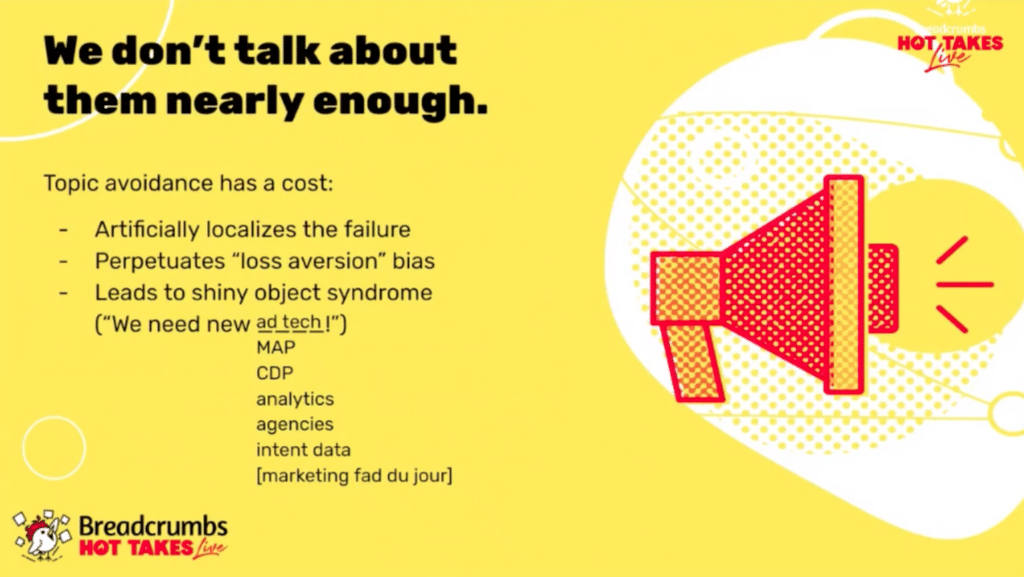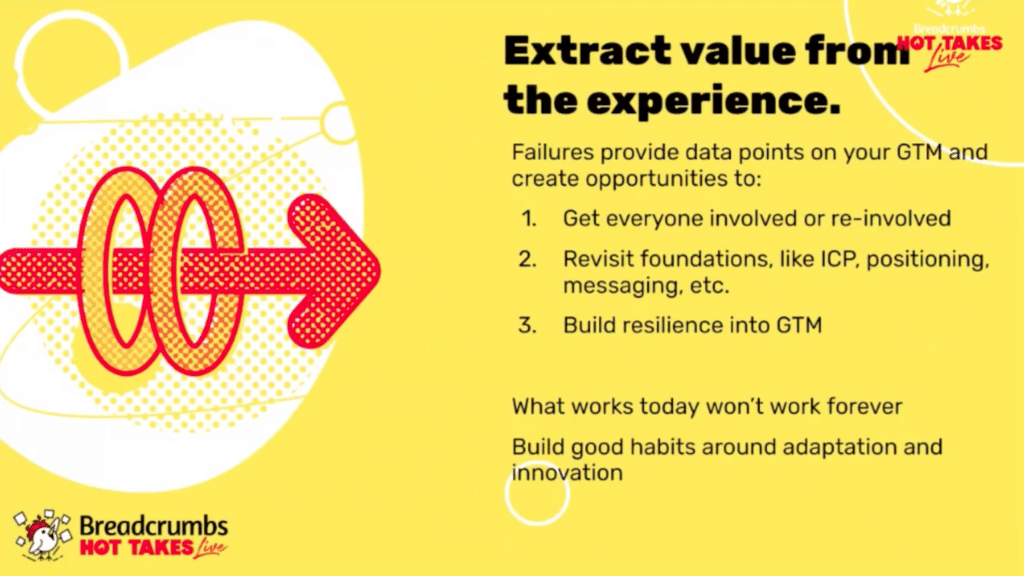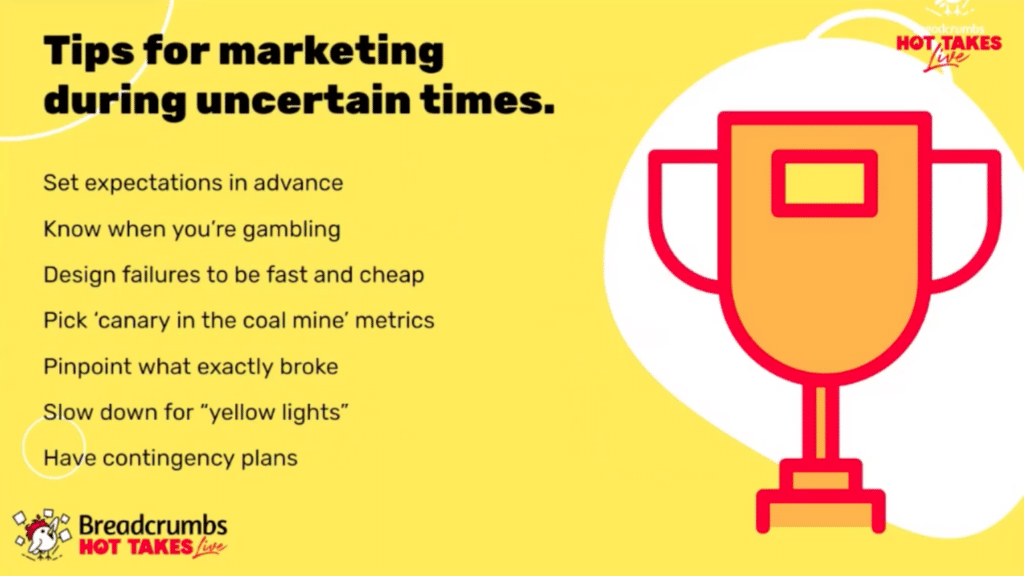Failing at marketing is a right of passage that too many companies try to avoid, instead of embracing it–and owning it!
In reality, the process of learning to market your business, product, or service is equally as important as the outcomes.
Every misstep and stumble is an important learning experience that paves the way for future success by providing firsthand insights into audiences, strategies, tactics, market positioning, and value props.
In this session with Karl Wierzbicki, you will learn:
- The virtues of failing
- Where companies typically fail at failing
- How to fail properly
[Transcript] Every Company Should Fail At Marketing
Although transcriptions are generally very accurate, just a friendly reminder that they could sometimes be incomplete or contain errors due to unclear audio or transcription inaccuracies.
Armando Biondi
The second half of the marketing track, Hot Takes Live. This is the second session, Karl, you are up next you are VP of marketing, and your hot take is a very spicy one! I cannot wait for this! Every company should fail at marketing.
Karl Wierzbicki
Yeah, awesome. Hey, thanks for the intro, Armando; I’m really excited to talk to everybody today about this topic, so let’s get into it.
My name is Karl Wierzbicki. I’ve been a marketer for 25 years, my entire career. All kinds of different roles, at all kinds of different companies, from enterprises and hypergrowth to bootstrap startups. I’ve been a copywriter. I’ve led the departments, all kinds of experience but the one common thread that goes through it all.
I work with go-to-market teams to improve execution and drive results in performance. The way that I do that is to make sure that we always have the customer at the focus of whatever marketing is doing and to make sure that we’re listening to what the data tells us, so we’ll get into that in the session.
Right now, I’m a marketing consultant, I’m self-employed, and I’m looking for my next big thing and two interesting facts about me: I love to speed-run Gong calls. I actually wish I could speed-run live meetings at 2.5x, but we’re still waiting for that functionality.
Also, folks that know me would probably vote me least likely to deliver a hot take in real life, so what you may notice as we go through today’s content; it may not fit the mold of a hot take, but I didn’t want to let this opportunity pass me by to try to demystify a topic for marketers, an issue that’s really vexed the profession since it it got started.
So, the title of this session is very intentionally chosen. Every company should fail at marketing, This is not to say that we should go out and intend to fail or that we should strive to fail, but that we should expect to fail.

The reason for that is we live in a very volatile, uncertain, complex, and ambiguous world. You could Google the VUCA acronym and find all kinds of great articles about it, but the nut of the concept is this: we live in a world where we don’t have all of the information or the opportunity to make perfect decisions, and the pace at which that uncertainty is growing is really outstripping the ability of marketers and companies to respond and adapt to it.
If you don’t believe the concept, just think back to some recent examples of plan killers that you may remember. We’ve got a workforce that is very chaotic. 33% have quietly quit and there is a talent shortage that is basically ongoing and enduring and predicted for the foreseeable future where there is more demand for certain roles than there is supply to meet it and that gap is widening in certain areas.
There’s an “economic downturn.” I’ve got it in quotes because although the economic indicators aren’t there for a recession, we see an enduring and remarkable pessimism in the marketplace that has basically slowed selling and purchasing down to a crawl and has a lot of companies kind of evaluating options for how they’re going to weather this and how long it’s going to take.
Then I’m sure a hundred other speakers this month have been talking about AI and how Chat GPT’s launch a few months ago took AI from being like an intellectual, academic concept and made it crack cocaine for CEOs and boards and investors, and It’s now like the number one priority facing every business.
How does this impact my business? How does this impact my customers’ business? Where do we fit into our business model?
All of this is wreaking havoc with business strategy, and marketing strategy, don’t believe me? McKinsey released a report recently that said out of the thousands of companies that S&P rates credit for, 75% of those are going to fail in the next four years. So this is an environment that is adversarial to marketing success and we should anticipate that failure happens and will happen more frequently.
So with that in mind, one of the things that, in my experience, I’ve realized is we don’t really talk about it in a productive way.

Certainly, we have conversations with the board and with our boss about why things went South, but generally speaking, in those conversations we try to provide enough of a post-mortem to be able to move on to the next thing gracefully.
We kind of avoid the topic and dealing with it in a productive way, and we should realize that topic avoidance has a very high cost. It artificially localizes the failure to marketing. Marketing touched this last, therefore they must be the ones that screwed it up, and that kind of approach ignores the whole upstream go-to-market food chain and marketing strategy.
Also, I think fear of failure perpetuates our human bias to loss aversion. As humans, we are hardwired psychologically to make decisions to minimize any kind of loss or risk, we have a fear of messing up, and that leads us to make smaller, safer bets, which is not really what a marketer should be shooting for.
We should be having big, bold bets and trying to have big rewards, and that can be the impact that marketing should generate for the organization.
Then, lastly, I mean, if you’re not doing a deep dive on why things went South, you have a very superficial assessment that leads to shiny object syndrome. We typically blame the toolset and say that the reason things went South is we didn’t have the latest greatest shiniest fanciest marketing, ‘what’s-it?’ Whether it’s automation tool or a content delivery platform or analytics or intent data whatever.
If you don’t dig deep and look for root causes you can artificially attach the blame to something superficial and never really put yourself in a position to actually learn from your mistake and that’s really the point of me speaking on this topic today to try to get us to shift our mindset a little bit and see the value in our failures.

When marketing doesn’t work, It’s providing data points on your go-to-market, and it’s giving the marketing team opportunities to do a few things that they wouldn’t otherwise necessarily have an opportunity to do.
Such as get everybody involved and try to figure out what happened and what could be done differently to improve things, gives marketing a chance to relitigate some of the assumptions that were made about business strategy and foundational elements like the ICP product positioning, messaging, etc.

Ebook
Ideal Customer Profile (ICP) Worksheet
Learn how to create an Ideal Customer Profile and build a successful sales strategy with this Ideal Customer Profile (ICP) Worksheet.
I mean, because of the foundational nature of these assets my experience is they typically outlive their value and get to be too long in the tooth.
So having a retrospective allows us to open the hood on that stuff, hold it up to the light of the day, and say, ‘Hey, does this still apply in our rapidly changing world, or do we need to actually adapt it and change it?’.
Lastly and most importantly, I think the real value that people can extract from failure in marketing is to build resilience into your go-to-market, and what I mean by that is it provides an opportunity to practice adaptation, communication, and innovation in marketing.
We take those failures, and we use them to build good habits for responding to the ever-changing world around us. I mean, even take a look at what worked from a marketing perspective a year ago.
That stuff’s not working now. What’s working today may not be working in six months. So we are in a profession where we need to be continually responding to and adapting our tactics and our strategies to the world around us and the economy and the customers and the pace of technology around us, and if we don’t we’re going to get left behind.
So, in some ways, failure is good practice for adaptation and Innovation. Take advantage of it.
So I couldn’t get away from talking about failure and imploring other people that they should talk about failure without providing an example from my own experience.

So, I want to tell you about a campaign that we ran at the company I was at previously, this is something that I inherited from a previous marketing leader, and the background is this; We changed our go-to-market strategy, we were moving from selling a do-it-yourself app development platform selling that to technical audiences and builders who would be using it to basically selling the products of the platform.
Taking the application platform, building some off-the-shelf solutions for specific business problems, and selling them to enterprise decision-makers so the folks who experience the problem directly.
Brand new for our company. Brand new for our brand, and we needed to educate the market and kind of build awareness that we were doing this the idea was we would use pay ads on LinkedIn, you know, a very popular playbook right now, and what we would do is get our content get our message in front of folks.
Have them channel back to the website, do word of mouth, share it with their friends, and eventually, we would educate them on the website and we would capture the demand there.
When I rolled up my sleeves, and kind of dug into this campaign, I noticed that there were a couple of problems that were kind of baked into it.
Number one; we were gambling with an unproven go-to-market strategy we had kind of talked to customers, and we had some qualitative input that said the go-to-market strategy is sound, but now we’re placing a big marketing investment behind it and market testing it in a very big way, in a very expensive way.
So we didn’t know that we were gambling, or at least we didn’t openly acknowledge we were gambling when this campaign was conceptualized and launched. The other thing was on investigation, the campaign tactic was actually not a great match for our budget and our go-to-market strategy.
LinkedIn advertising is great, but it’s also very expensive, and for a bootstrapped company that doesn’t have a lot of marketing budget or resources, It quickly consumed a significant portion of the marketing budget and actually took money away from other programs.
Also, our go-to-market strategy targeted multiple non-overlapping audiences, so ideally, what you do is you would multiply your media budget for each of those audiences to maintain your reach and frequency, when in fact, what we ended up doing was dividing, which is never a great idea.
There were expectation mismatches between what the sales leaders and the board was expecting the campaign to generate and what the marketing team was expecting the campaign to generate.
That misalignment on leads and pipeline was going to be problematic. No success metrics were identified leading into the campaign. We didn’t know what we would say qualified it as a win or a failure. We didn’t have attribution set up, and we had no set timeline or framework for how to make the call whether this campaign was working or not.
These are all yellow lights, things that you should slow down for and deal with when they get experienced or identified, and what you shouldn’t do is floor it and try to beat the light and hope that you’ve gotten far enough past it that it doesn’t come back to bite you. Never a great approach.
So one of the things I did was start to reset expectations with the leadership team and the board about what we’re trying to do with the demand creation campaign. Given the time frame in an enterprise kind of B2B sale, it would be a while before the actual financial results would start to trickle in from this.
So, how do we identify some canaries in the coal mine? Some leading indicators that would give us a hunch whether or not we could expect the campaign to generate the final desired result or whether it was not going to work.
We looked at things like the volume of branded traffic to our website. We looked at things like session duration on campaign-associated pages, the number of resources per session that were consumed, and account engagement, account coverage, and things like that.
We wanted to take a look at those and see if we could move the needle on those, if those moved, then conceivably, we would get the expected long-term outcome, and in that way, we could evaluate the strategy and separately evaluate the tactic and see whether or not one the other or both were not going to work or were going to work and then we set some cutoff dates.
If we didn’t see the leading indicators move. “Hey let’s kill it after six months.” if we did see the move, let’s let it run its course for a year and see what we could see.
So, in the end, we had a really strong performance for account coverage and account engagement with the ads. We had a really good engagement on our website. We saw all of our session metrics going up. We had a good degree of confidence that we were getting the right message in front of the right audience and that they were interested enough with it to engage with the content.
What we didn’t see was a correlation between campaign activity and branded traffic volume to the site. As well, we were kind of monitoring our high-intent form fills, noticing they were slowly trending up but not at a pace that would really make us feel great about the amount that we were spending.
Attribution never got dialed in entirely, even though we implemented hybrid attribution. What we ended up doing was basically taking all the things we could definitely attribute, putting them in a bucket, and everything that was left over. Let’s over-attribute that to the campaign and make our decision based on that.
In the end, even with that approach over-attributing to the campaign, the ROI didn’t make sense. The payback period was too long, the acquisition costs were too high, and we pulled the plug on it. But, We were able to validate that the GTM was working and just the campaign was not a great choice for our particular audience and Company.
So in the interest of time, I’m going to gloss over this, but the case study and what my experiences have kind of indicated time and again is certain things come up over and over again.

These are common things that you can plan for, and what you should do is build a checklist for what you could do to mitigate failure.
Build a checklist for what you should do in anticipation of failure, and then build the checklist of what you’ve done when things have gone wrong and in doing that, you can actually make the most out of an otherwise bum situation and get some value in it and build your credibility and then build your chances of success in the future.

Hot Takes Live
Replays
Catch the replay of Hot Takes Live, where 30 of the top SaaS leaders across Marketing, Sales, and RevOps revealed some of their most unpopular opinions about their niche.
These leaders shared what lessons they learned and how they disrupted their industry by going against the grain (and achieved better results in the process).
Armando Biondi
Karl, this is great; thank you so much.
Karl Wierzbicki
Yeah, for sure, we’ll turn it over to questions now.
Armando Biondi
Yeah. Can you go back to that slide for one second? Because I had a question, if anyone else had from the audience, you’re more than welcome to just write them in the chat, would pick them up from there.
My one question was really around the observation that you are, to some degree, normalizing the fact that marketing is a probabilistic effort; it’s a portfolio of initiatives some of those initiatives will be more successful than others, some will not be successful at all and so one being aware of that and accepting that and making that part of the conversation is necessary.
Two, there might be things that you can do to help and enable a healthy approach around it. Right, because what you’re saying is very true, but also, it’s not very safe. Right, because you’re saying that some people who have their job in marketing the panel initiatives will see those initiatives fail, so how do you have that conversation in a healthy, productive way?
Karl Wierzbicki
Yeah, I think it’s a good question.
So I mean, obviously, you want to make winning bets more often than you make losing bets, but I think that the signals that you send after making a losing bet are extremely important to your credibility and the marketing department’s credibility, and if we do not do a deep-dive to understand root causes and to understand exactly what failed and then make adjustments to prevent it in the future.
I mean, we will always be seen as gamblers in the profession, which we want to avoid when Product lays an egg, Product has a whole checklist and procedure for doing the post-mortem and understanding how they prevent it from ever happening again, and implementing some some policy procedure and practice to make sure that you know we’re just not going to make that mistake again, and I feel like as marketers we don’t send those signals often enough.
That we’re very serious about what went wrong and that we don’t just view it as a blip or an ‘oh well.’
Armando Biondi
You’re not equally comfortable in saying that some stuff is going to fail, but to your point, if and when something does fail, there needs to be a post-mortem, and there needs to be some learnings coming out of it to do better the next time because otherwise what’s the point?
Karl Wierzbicki
Yeah, precisely, I mean, I say to me, it comes down to having credibility with the CEO, having credibility with the CFO, and having credibility with the rest of the organization that’s like we are being very logical and very systematic about the way that we’re doing things.
Armando Biondi
I just have to stop you there–yeah, this was great, though.
Karl Wierzbicki
Yeah, thanks, Armando, that’s very much appreciated. If anybody wants to deep-dive or has questions, connect with me on LinkedIn. I would love to continue the conversation.
